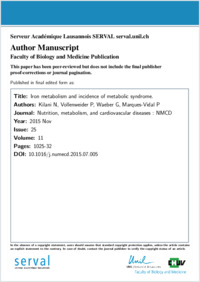Iron metabolism and incidence of metabolic syndrome.
- Kilani N Department of Internal Medicine, Internal Medicine, Lausanne University Hospital, Lausanne, Switzerland. Electronic address: Nadia.Kilani@unil.ch.
- Vollenweider P Department of Internal Medicine, Internal Medicine, Lausanne University Hospital, Lausanne, Switzerland. Electronic address: Peter.Vollenweider@chuv.ch.
- Waeber G Department of Internal Medicine, Internal Medicine, Lausanne University Hospital, Lausanne, Switzerland. Electronic address: Gerard.Waeber@chuv.ch.
- Marques-Vidal P Department of Internal Medicine, Internal Medicine, Lausanne University Hospital, Lausanne, Switzerland. Electronic address: Pedro-Manuel.Marques-Vidal@chuv.ch.
- 2015-08-29
Published in:
- Nutrition, metabolism, and cardiovascular diseases : NMCD. - 2015
Ferritin
Iron
Metabolic syndrome
Prospective study
Transferrin
incidence
Adult
Alanine Transaminase
Aspartate Aminotransferases
Biomarkers
Body Mass Index
C-Reactive Protein
Cholesterol, HDL
Cholesterol, LDL
Female
Ferritins
Follow-Up Studies
Humans
Incidence
Iron
Logistic Models
Male
Metabolic Syndrome
Middle Aged
Multivariate Analysis
Prospective Studies
Transferrin
English
BACKGROUND AND AIMS
Whether iron metabolism affects metabolic syndrome (METS) is debated. We assessed the association between several markers of iron metabolism and incidence of METS.
METHODS AND RESULTS
Data from 3271 participants (1870 women, 51.3 ± 10.4 years), free of METS at baseline and followed for 5.5 years. The association of serum iron, ferritin and transferrin with incident METS was assessed separately by gender. Incidence of METS was 22.6% in men and 16.5% in women (p < 0.001). After multivariate adjustment, a positive association was found between transferrin and incident METS in men: odds ratio (OR) and 95% confidence interval for the fourth relative to the first quartile 1.55 (1.04-2.31), p for trend = 0.03, while no association was found for iron OR = 0.81 (0.53-1.24), p for trend = 0.33 and ferritin OR = 1.30 (0.88-1.92), p for trend = 0.018. In women, a negative association was found between iron and incident METS: OR for the fourth relative to the first quartile 0.51 (0.33-0.80), p for trend<0.03; the association between transferrin and incident METS was borderline significant: OR = 1.45 (0.97-2.17), p for trend = 0.07 and no association was found for ferritin: OR = 1.11 (0.76-1.63), p for trend = 0.58.
CONCLUSION
Transferrin, not ferritin, is independently associated with an increased risk of incident METS; the protective effect of iron in women should be further explored.
Whether iron metabolism affects metabolic syndrome (METS) is debated. We assessed the association between several markers of iron metabolism and incidence of METS.
METHODS AND RESULTS
Data from 3271 participants (1870 women, 51.3 ± 10.4 years), free of METS at baseline and followed for 5.5 years. The association of serum iron, ferritin and transferrin with incident METS was assessed separately by gender. Incidence of METS was 22.6% in men and 16.5% in women (p < 0.001). After multivariate adjustment, a positive association was found between transferrin and incident METS in men: odds ratio (OR) and 95% confidence interval for the fourth relative to the first quartile 1.55 (1.04-2.31), p for trend = 0.03, while no association was found for iron OR = 0.81 (0.53-1.24), p for trend = 0.33 and ferritin OR = 1.30 (0.88-1.92), p for trend = 0.018. In women, a negative association was found between iron and incident METS: OR for the fourth relative to the first quartile 0.51 (0.33-0.80), p for trend<0.03; the association between transferrin and incident METS was borderline significant: OR = 1.45 (0.97-2.17), p for trend = 0.07 and no association was found for ferritin: OR = 1.11 (0.76-1.63), p for trend = 0.58.
CONCLUSION
Transferrin, not ferritin, is independently associated with an increased risk of incident METS; the protective effect of iron in women should be further explored.
- Language
-
- English
- Open access status
- green
- Identifiers
-
- DOI 10.1016/j.numecd.2015.07.005
- PMID 26315622
- Persistent URL
- https://folia.unifr.ch/global/documents/43063
Statistics
Document views: 23
File downloads:
- fulltext.pdf: 0
